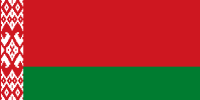 Belarus, (pronounced /bɛləˈruːs/ bel-ə-ROOS; Belarusian: Беларусь, Russian: Беларусь or Белоруссия, Belorussia see Etymology), officially the Republic of Belarus, is a landlocked country in Eastern Europe, bordered clockwise by Russia to the northeast, Ukraine to the south, Poland to the west, and Lithuania and Latviato the northwest. Its capital is Minsk; other major cities include Brest, Grodno (Hrodna), Gomel (Homiel), Mogilev (Mahilyow) and Vitebsk (Viciebsk). Forty percent of its 207,600 square kilometres (80,200 sq mi) is forested, and its strongest economic sectors are agriculture and manufacturing.
Belarus, (pronounced /bɛləˈruːs/ bel-ə-ROOS; Belarusian: Беларусь, Russian: Беларусь or Белоруссия, Belorussia see Etymology), officially the Republic of Belarus, is a landlocked country in Eastern Europe, bordered clockwise by Russia to the northeast, Ukraine to the south, Poland to the west, and Lithuania and Latviato the northwest. Its capital is Minsk; other major cities include Brest, Grodno (Hrodna), Gomel (Homiel), Mogilev (Mahilyow) and Vitebsk (Viciebsk). Forty percent of its 207,600 square kilometres (80,200 sq mi) is forested, and its strongest economic sectors are agriculture and manufacturing.
Until the 20th century, the lands of modern day Belarus belonged to several countries, including the Principality of Polotsk, the Grand Duchy of Lithuania, the Russian Empire, and the Polish–Lithuanian Commonwealth. As a result of the Russian Revolution, Belarus became a founding constituent republic of the Soviet Union and was renamed into the Belorussian SSR. The final unification of the modern day Belarusian lands took place in 1939 when lands that were part of the Second Polish Republic were united with Belorussian Soviet Socialist Republic. The territory and its nation were devastated in World War II, during which Belarus lost about a third of its population and more than half of its economic resources; the republic was redeveloped in the post-war years. Due to the impact of World War II, the Belorussian SSR became a founding member of the United Nations, along with the Soviet Union and the Ukrainian SSR.
The parliament of the republic declared the sovereignty of Belarus on 27 July 1990, and following the collapse of the Soviet Union, Belarus declared independence on 25 August 1991. Alexander Lukashenko has been the country’s president since 1994. Under his lead and despite objections from Western governments, Soviet-era policies, such as state ownership of the economy, have been implemented. Since 2000, Belarus and Russia signed a treaty for greater cooperation, with some hints of forming a Union State.
Most of Belarus’s population of 9.85 million reside in the urban areas surrounding Minsk and other voblast (regional) capitals. More than 80% of the population are native Belarusians, with sizable minorities of Russians, Poles and Ukrainians. Since a referendum in 1995, the country has had two official languages:Belarusian and Russian. The Constitution of Belarus does not declare an official religion, although the primary religion in the country is Russian Orthodox Christianity. The second most popular, Roman Catholicism, has a much smaller following by comparison, but both Orthodox and Catholic Christmas and Easter are officially celebrated as national holidays.
Belarusian literature began with 11th-to 13th century religious writing; the 12th century poetry of Cyril of Turaw is representative. By the 16th century, Polotsk resident Francysk Skaryna translated the Bible into Belarusian. It was published in Prague and Vilnius between 1517 and 1525, making it the first book printed in Belarus or anywhere in Eastern Europe. The modern period of Belarusian literature began in the late 19th century; one important writer was Yanka Kupala. Many Belarusian writers of the time, such as Uładzimir Žyłka, Kazimir Svayak, Yakub Kolas, Źmitrok Biadula and Maksim Haretski, wrote for a Belarusian language paper called Nasha Niva, published in Vilnius.
Since winning independence from the Soviet Union in 1991, Belarus has moved slowly on privatization and other market reforms, emphasizing instead close economic relations with Russia. About 80% of all industry remains in state hands, and foreign investment has been hindered by a climate hostile to private businesses. The banks, which had been privatized after independence, were renationalized after President Lukashenko took office in 1994. Economic output, which declined for several years, revived somewhat in the late 1990s, but the economy remains dependent on Russian subsidies.
Notes from Wikipedia and Answers.com









